Choosing the right battery size for your trolling motor is essential to ensure optimal performance and efficiency on the water. In this comprehensive guide, we will cover all you need to know about choosing the right battery size to meet your boating requirements.
Table of Content
- Part 1: Understanding Trolling Motor Batteries
- 1.1 Types of trolling motor batteries
- 1.2 Factors to consider when choosing a trolling motor battery
- Part 2: What Size Battery is Suitable for Trolling?
- 2.1 How Does a Battery Size Affect a Boat’s Performance
- 2.2 Factors to consider when choosing the right battery size
- 2.3 Recommended battery size based on the above factors
- 2.4 Advantages and disadvantages of using larger or smaller batteries
- Part 3: Battery Maintenance and Care Tips
- Choosing The Right LiFePO4 Battery for Your Trolling Motor
Part 1:Understanding Trolling Motor Batteries
1.1 Types of Trolling Motor Batteries
Trolling motor batteries are crucial components of any electric trolling motor system. They provide the power necessary to propel the boat forward, and selecting the right type of battery can greatly impact your boating experience.
Trolling motor batteries are broadly categorized into three types: lead-acid batteries, AGM batteries, and lithium-ion (LiFePO4) batteries. We will discuss the strengths and weaknesses of each type in detail below.
Lead-Acid Wet Batteries
The most commonly found type of battery used for trolling motors is the lead-acid wet cell battery. These batteries, essentially similar to car batteries, have been on the market for many years. Although certain lead-acid wet cells are optimized for deep cycle marine use, they don't differ significantly from standard car batteries. While they remain widely available, they are considered outdated in terms of technology, as there are now superior options available.
If you decide to go with a lead-acid wet cell battery for your trolling motor, there are a few precautions to consider before purchasing and installing one. The installation process should be approached with caution and in the proper sequence.
One concern is the potential for spilled acid while filling the cells with distilled water. This can pose a real hazard to yourself, your boat, and the environment. Although these batteries are affordable and functional, their use is generally not recommended, especially for boats, due to this safety issue.
Advantages of Lead Acid Wet Batteries:
- Affordable
- Widely available
- Easy to find replacement parts
- Can handle shallow discharges
Disadvantages:
- Require regular maintenance, such as filling with distilled water and cleaning terminals
- Shorter lifespan compared to other battery types
- Heavy and bulky
AGM Batteries
AGM batteries have become the most popular choice for marine applications due to their unique design and safety features. Unlike traditional lead acid batteries, AGM batteries are completely enclosed and non-spillable.
The main difference lies in the internal components of these batteries. While lead acid batteries use hydrochloric acid and lead plates, AGM batteries incorporate glass mats and a gel substance to facilitate the chemical reactions that store electrical energy. This construction not only enhances the battery's performance but also eliminates the risk of leakage, making it a reliable option for various applications, including bass fishing in wet conditions.
The sealed nature of AGM batteries is particularly crucial for maintaining their long-term health and ensuring safe operation. In comparison, even a slight loosening of one of the cell caps in a lead acid battery can result in leakage. This inherent weakness is absent in AGM batteries, making them a trusted choice for consumers seeking a reliable and hassle-free power source.
Advantages:
- Longer lifespan compared to traditional lead-acid batteries
- Virtually maintenance-free
- More resistant to vibration and shock
- Can handle deep discharges
Disadvantages:
- More expensive than traditional lead-acid batteries
- Still heavy
Lithium Batteries
Lithium batteries offer exceptional power and are incredibly lightweight. One of their key advantages is their flat power discharge curve, allowing for maximum power output until the battery is fully depleted. For example, traditional 12V 100Ah lead-acid battery weights 60-70lbs, however, LiTime 12V 100Ah TM LiFePO4 lithium battery weights at only 22 lbs. Additionally, it also has low-temperature protection.
Compared to traditional batteries, which can weigh around six pounds and take up space, lithium batteries are compact and can easily fit into small compartments. They are available in various sizes and amp hour ratings, allowing boat owners to choose the most suitable battery for their vessel.
For kayak fishing, using a lithium battery is highly recommended. They have minimal impact on the kayak's performance due to their small size and light weight. Although they tend to be more expensive, they are considered the best choice for most kayak setups. In fact, many top trolling motors for kayaks come equipped with lithium batteries.
Lithium batteries are becoming increasingly popular for trolling motor applications, despite their higher cost.
Advantages:
- Longer lifespan in contrast to traditional lead-acid batteries.
- Lightweight and compact
- Maintenance-free
- Can handle deep discharges
Disadvantages:
- Expensive
- Requires specialized charging equipment
- May not be compatible with all trolling motors on the market
To sum up, the selection of an appropriate trolling motor battery is influenced by various factors such as cost, lifespan, and maintenance requirements. Lead-acid batteries are economical but require frequent upkeep, whereas AGM batteries provide extended lifespan at a higher price point. Lithium-ion batteries are the most advanced option with a high price tag. Being aware of the strengths and limitations of each battery type can help you make an informed decision while selecting the ideal trolling motor battery for your system.
1.2 Factors to consider when choosing a trolling motor battery
When selecting a trolling motor battery, there are crucial factors to consider beyond just the battery types. The battery capacity, measured in ampere-hours (Ah), is one such factor that determines how much energy the battery can store and supply to the motor. Higher capacity batteries offer longer run times but are heavier and more expensive.
Another critical factor is the voltage of the battery, which should match the power needs of the trolling motor. Typically, 12-volt or 24-volt batteries are used for trolling motors, depending on their power requirements. Using the wrong voltage battery can damage the motor or reduce its efficiency.
For trolling motors with up to 55 pounds of thrust, a single 12V battery is sufficient. More powerful motors up to 80 pounds of thrust require two 12V batteries wired in series to provide a total of 24 volts. The most potent trolling motors generating over 80 pounds of thrust usually require three 12V batteries wired in series to provide a total of 36 volts. Learn more about LiFePO4 Lithium Batteries In Series & Parallel.
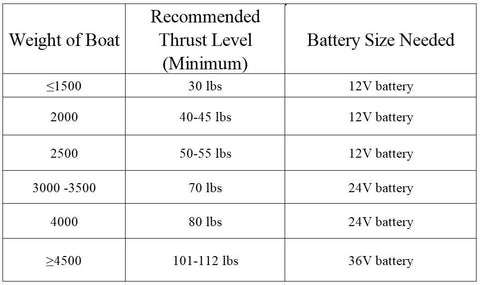
It's worth noting that certain trolling motors are designed to work with specific battery types, so it's crucial to check the manufacturer's recommendations before purchasing a battery.
Maintaining your battery is also critical, regardless of its type. For lead-acid batteries, regular maintenance like fluid level checks and terminal cleaning is essential for optimal performance and longevity. AGM batteries require less maintenance but should be periodically checked for charging and storage conditions. Lithium-ion batteries require minimal maintenance but must be charged using a compatible charger to avoid damage.
Selecting the ideal battery for your trolling motor depends on your requirements and budget. It's vital to consider factors such as capacity, voltage, and compatibility with your motor, as well as the pros and cons of each battery type. Proper maintenance can help ensure that your battery lasts longer and performs at its best.
Part 2: What Size Battery is Suitable for Trolling?
2.1 How Does a Battery Size Affect a Boat’s Performance
Choosing the right size battery for your boat is crucial for optimal performance and safety. The size of the battery directly impacts the boat's electrical system, engine performance, gas consumption, and overall stability. Using an improper battery size can strain the engine and lead to higher fuel consumption. It can also cause damage to the boat's electrical components, resulting in appliance failure and potential hazards such as fluid spills, sparks, and overheating.
An oversized or undersized battery can have detrimental effects on the boat's performance and battery life. Oversized batteries can place unnecessary strain on the electrical system, leading to potential damage and reduced efficiency. On the other hand, undersized batteries may not provide sufficient power for the boat's electrical needs, resulting in a shorter run time or complete power failure.
It is important to consult experts or the boat manufacturer to determine the appropriate battery size for your specific boat model. Consider the power requirements of your electrical systems, the desired run time, weight distribution, and your budget when choosing a battery size. Taking these factors into account will ensure that your boat operates efficiently and safely.
2.2 Factors to consider when choosing the right battery size
- Boat size and weight: The size and weight of the boat are crucial factors to consider when selecting a trolling motor battery size. Larger boats will require larger batteries with higher amp-hour (Ah) ratings to provide enough power to the trolling motor for longer periods.
- Trolling motor thrust: The amount of thrust that the trolling motor generates also affects the battery size needed. The higher the thrust, the more power the motor will require, and the larger the battery will need to be to provide enough power.
- Fishing conditions: Wind and currents can impact the amount of power needed to operate the trolling motor. Strong winds or currents will require more power, which means a larger battery will be necessary.
2.3 Battery Size for Trolling Motor
The most common battery group sizes for trolling motors are 24, 27, and 31. However, the appropriate size will depend on the size of your boat, the weight you're carrying, and the motor's power requirements.
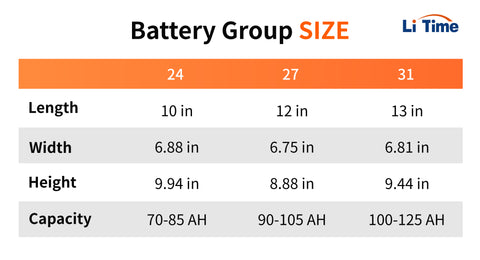
For smaller boats with lighter loads and less powerful motors, a group 24 battery may be sufficient. Group 24 batteries typically have dimensions of around 10 x 6.88 x 9.94 inches and a capacity of around 70-85 Ah. However, LiTime group 24 LiFePO4 battery has the capacity of 100Ah.
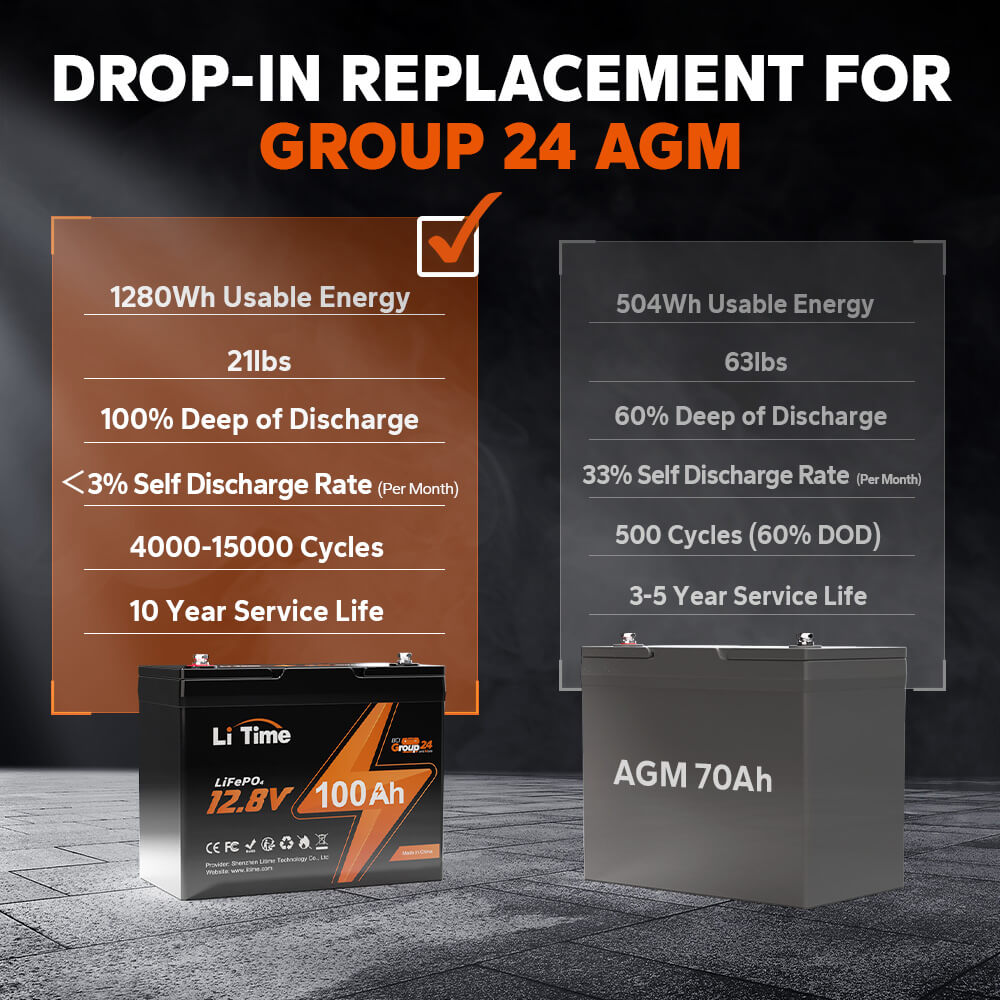
For larger boats with heavier loads and more powerful motors, a group 27 or 31 battery may be necessary. Group 27 batteries typically have dimensions of around 12 x 6.75 x 8.88 inches and a capacity of around 90-105 Ah. Group 31 batteries are even larger, with dimensions of around 13 x 6.81 x 9.44 inches and a capacity of around 100-125 Ah. Below is the format of other BCI battery size.
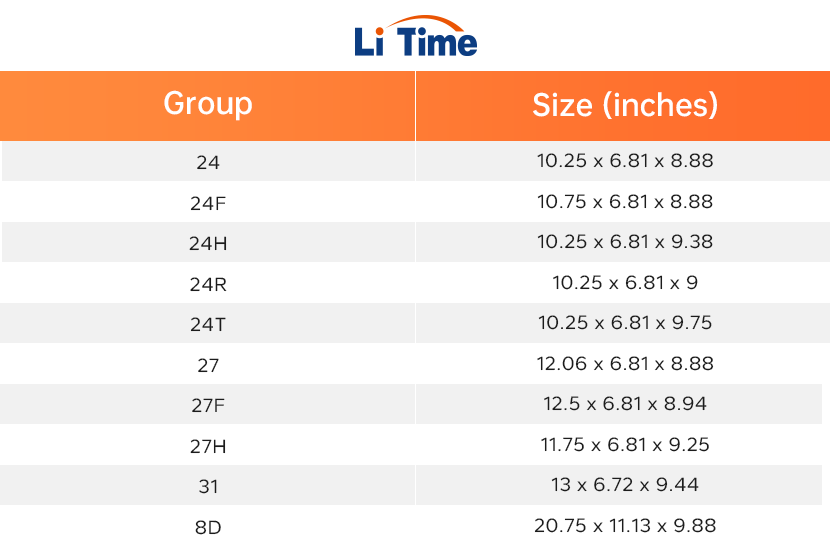
2.4 Advantages and disadvantages of using larger or smaller batteries
Using a larger battery will provide more power and longer run times for the trolling motor. However, larger batteries are heavier and bulkier, which can affect the boat's performance and maneuverability. LiTime has 36V trolling motor battery, which is suitable for up to 120lbs trolling motor.
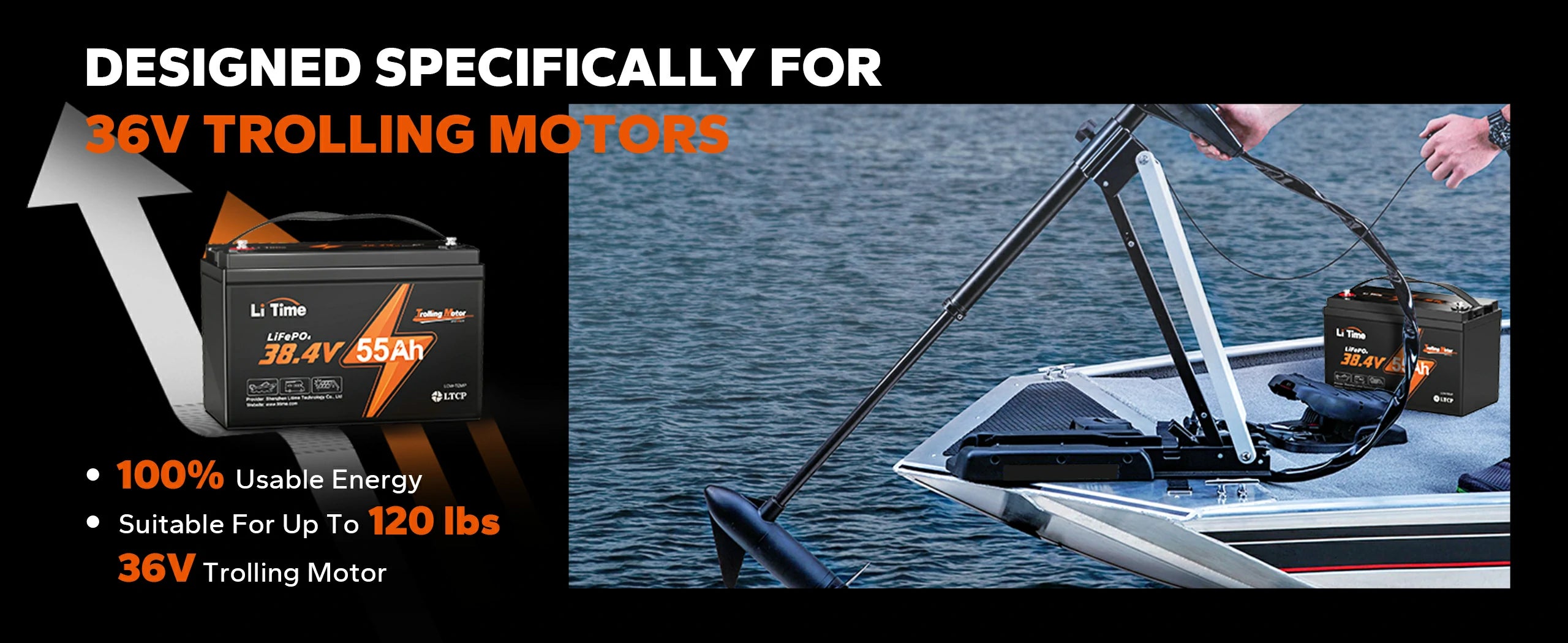
In contrast, smaller batteries are lighter and easier to handle but may not provide enough power for extended use. Therefore, it's essential to strike a balance between the battery size and the boat's weight, thrust, and fishing conditions to ensure optimal performance.
Therefore, it is crucial to find a battery that strikes the right balance between size and performance based on factors such as boat weight, thrust, and fishing conditions. The solution lies in upgrading to a LiFePO4 battery, which offers high energy density and lighter weight.

Part 3: Battery Maintenance and Care Tips
To ensure optimal performance, longevity, and safety of your electric trolling motor system, it is imperative to prioritize the maintenance and care of your trolling motor batteries. Below are some tips and guidelines to help you with this task:
3.1 Charging Techniques:
It is essential to use a charger that is specifically designed for your battery type to ensure optimal performance and avoid potential damage. Make sure the charger matches the voltage of your battery, if you are not sure, refer the table below. Avoid overcharging it as it may reduce its lifespan or cause damage. Charge the battery after every use and refrain from leaving it in a discharged state for an extended period. Can I charge LiFePO4 battery with a normal charger? Read on to find out!

3.2 Battery Storage Tips
Proper storage of your battery is crucial for its longevity and performance. Store the battery in a cool, dry place away from direct sunlight and extreme temperatures.
It is also recommended to disconnect the battery from the trolling motor before storage. If you're using a flooded lead-acid battery, maintain proper water levels. If storing the battery for an extended period, charge it fully before storage and recharge it periodically.
3.3 Signs of a Failing Battery
It is crucial to keep an eye out for signs of a failing battery to avoid safety hazards and ensure optimal performance. Signs may include difficulty starting the trolling motor, reduced power output, slow or incomplete charging, bulging or deformed battery case, and leaking or corrosion around the terminals. If you notice any of these signs, it may be time to replace your battery or seek professional assistance.
Choosing The Right LiFePO4 Battery for Your Trolling Motor
| Voltage of Motor | Motor Thrust | Recommended Max Amp of Batteries | Recommended LiTime LiFePO4 Batteries | Recommended Reasons |
|---|---|---|---|---|
| 12V | 20 ~ 30 lb | 50A | LiTime 12V 50Ah Lithium Battery | Cost-effective |
| 12V | 30 ~ 70 lb | 100A | LiTime 12V 100Ah Lithium Battery | Cost-effective, Low-temp, Lighter |
| 24V | 70 ~ 100 lb | 100A | LiTime 24V 100Ah Lithium Battery | Cost-effective |
| 36V | 100 ~ 120 lb | 100A | LiTime 38.4V 55Ah Lithium Battery | One single battery is enough |
This table summarizes the recommended LiTime LiFePO4 lithium batteries based on the voltage of the motor, motor thrust, and the recommended maximum amperage of the batteries, along with the specific reasons for each recommendation.
Conclusion
In conclusion, selecting the appropriate battery size for your trolling motor is crucial to ensure optimal performance and longevity. Using the wrong size can lead to reduced power output, shorter battery life, and potential safety hazards. Therefore, it's essential to consider factors like the motor's thrust, boat weight, and usage patterns to determine the right battery size.
As discussed earlier in this article, the best way to choose the correct battery size for your trolling motor is by referring to the manufacturer's recommendations or consulting with an expert. Additionally, be sure to maintain and care for your battery properly by following the charging, storage, and maintenance tips provided here.
By taking the time to choose the right battery size and caring for it correctly, you can enjoy a more efficient and reliable trolling motor system. So, don't overlook this critical aspect of your boating experience, and make the right battery choice today! Learn more about new-users benefis from LiTime.








